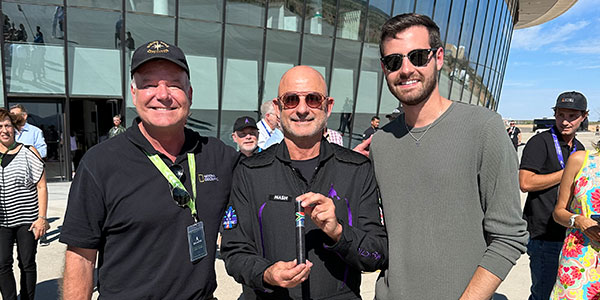First Fossils of Ancient Human Relatives Embark on a Journey to Space
In a historic first, two fossils of ancient human relatives have traveled to space today on the 8th of September 2023 as a tribute to the contribution of all human ancestors and ancient human relatives for their part in making the ultimate gesture of human exploration and technological advancement possible – space flight. Fossils of the two-million-years-old South African fossil hominin species Australopithecus sediba and the 250,000 years old hominin species Homo naledi, flew on the 3rd Virgin Galactic commercial space flight, carried by astronaut Timothy Nash, a South African born, South African and British citizen, conservationist and entrepreneur, closely involved with human origins research in Africa.

Travelling onboard Virgin Galactic’s spaceship, VSS Unity, the two fossils, held safely in a carbon fiber container, departed from Spaceport America, carried by the mothership, VMS Eve, to an altitude of 45,000 – 50,000 feet (13.7 – 15km), before VSS Unity separated from the mothership and ignited its rocket engine for the climb to suborbital space.
“The journey of these fossils into space represents humankind’s appreciation of the contribution of all of humanity’s ancestors and our ancient relatives. Without their invention of technologies such as fire and tools, and their contribution to the evolution of the contemporary human mind, such extraordinary endeavors as spaceflight would not have happened,” says Professor Lee Berger, a National Geographic Explorer in Residence, Carnegie Fellow and Director of the Centre for the Exploration of the Deep Human Journey at the University of the Witwatersrand in South Africa.
Aboard VSS Unity was the clavicle of the Type specimen of sediba, the first remains of the extinct species to be discovered by Matthew Berger in 2008, who was nine years old at the time, from the site of Malapa in the Cradle of Humankind World Heritage site just outside of Johannesburg, South Africa. Sediba has been recognised as a potential candidate species to have given rise to our own genus Homo. The second fossil is a thumb bone of Homo naledi discovered at Rising Star Cave, also in the Cradle of Humankind.
“This expedition is a tribute to science and discovery and signifies the possibilities of connecting our past with our future. From the exploration of the deep human journey beneath the Earth to the technological advancement that takes us to the edge of space – this moment traverses time and space and more importantly provides hope of what could be in the future,” says Prof. Zeblon Vilakazi (FRS), a nuclear physicist and the Vice-Chancellor and Principal of the University of the Witwatersrand in Johannesburg, South Africa, where the fossils are curated.
“The fossils were carefully chosen not only for their symbolic importance, but also because they are among the most documented fossils of hominins in existence, with casts, scans and images available across the world due to our scientific and open access efforts,” says Dr Bernhard Zipfel, Curator of Collections at the University of the Witwatersrand.
As the representative body of the South African government responsible for conserving and preserving the sites within the Cradle of Humankind UNESCO World Heritage site, and also responsible for bringing awareness of the importance of this heritage to the world, Matthew Sathekge, Chief Executive Officer of the Cradle of Humankind World Heritage Site and Dinokeng Projects of the Gauteng Department of Economic Development, says they were thrilled to watch the inspirational journey of these fossils from South Africa into space.
“We sincerely hope it brings further awareness of the importance of our country and the African continent to understanding the journey of humankind that has led to this historic moment where commercial spaceflight is possible,” says Sathekge.
The fossils travelled from South Africa earlier this week, hand carried by Berger and delivered to Spaceport America.
Mike Moses, President Missions and Safety, Virgin Galactic, expressed his thoughts on the spaceflight these fossils flew on today. “For our third commercial spaceflight mission, designated ‘Galactic 03’, we created a special astronaut patch that was created to commemorate the flight. The patch includes elements of the South African, British, and American flags to highlight the nationalities and affiliations of the astronauts onboard and it also carries two blue stars, to signify the sediba and naledi fossils carried on the spaceflight. It was a privilege to fly these incredible specimens aboard today, and a beautiful way to highlight the importance of human exploration.”
“These fossils represent individuals who lived and died hundreds of thousands of years ago, yet were individuals who likely gazed up at the stars in wonder, much as we do,” says Matthew Berger who discovered the clavicle of sediba and was one of the first people into the Dinaledi Chamber at Rising Star, where the finger bone of naledi was discovered.
“I imagine they never could have dreamed while alive of taking such an incredible journey as ambassadors of all of humankind’s ancestors.”
The fossils were handed to Nash by Matthew Berger in a brief ceremony just before the flight, and were carried on Nash’s person during the flight to and from space.
“The magnitude of being among the first civilians going into space, and carrying these precious fossils, has taken a while to sink in, during all of the preparations for the flight,” says Nash, “But I am humbled and honored to represent South Africa and all of humankind, as I carry these precious representations of our collective ancestors, on this first journey of our ancient relatives into space.”
It is the intention for the fossils, along with memorabilia from the flight, to be placed on display in museums and other institutions in Africa and around the world after their return to South Africa.

